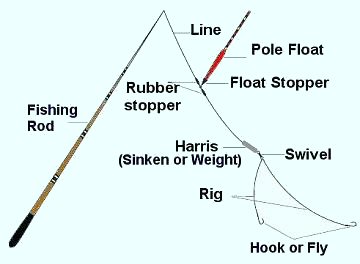
Powerful Extra-Sensitive Telescopic Fishing Poles made of High Modulus Carbon Manufactured In Japan.
How to attach line to a fishing pole?
How to attach float to the line?
How to roll sinker around the line?
How to cast telescopic pole whip?
How to fish with a pole?
How to land a fish?
How to extend and insert telescopic pole?
If rod sections get stuck at a joint?
Take a good care of your rod
3.6 meters poles
4.5 meters poles
5.4 meters poles
6.3 meters poles
7.2 meters poles
8.0 meters poles
9.0 meters poles
10 meters poles
12 meters poles
13 meters poles
14 meters poles
16 meters poles
17 meters poles
18 meters poles
20 meters poles
21 meters poles
The quality of the fishing rod you hold and the line you use are the two things that affect your sense of feel. The rod blank and action determine the amount of vibration that travels from the bait up through the line to the hand. Performance and comfort are extremely important. A quality rod is worth the price and using nice rod will increase your fishing success. It is always better to purchase one best quality fishing rod instead of using the same amount of money to buy several cheaper rods.
These telescopic fishing poles of the highest quality are lightweight and incredibly strong, thanks to a
High Modulus Graphite Carbon manufactured in Japan, using Japanese Design, Engineering and Technology. We all know that when design and engineering are concerned the Japanese technology is still the best in the world by far. Special low resin high tension graphite on the blank are added for an outstanding power. Extra Cross wave enchancement graphite lays on the surface of joint added for the security. Accurate weight calculation of each section builds this a good balance fighting match.
Very Light Weight allows fishing all day without arm fatigue, to be able to concentrate ground baits in very small areas of water and be able to fish outside, over or above of your feed area with the utmost accuracy.
Flexibility and
Extra Fast, Fast or Medium Action makes these poles perfect for casting light float rigs; It allows you to see the most delicate fish bites.
Power helps you actually fight the big fighter.
Length allows to get you deep into the brush where large fish hide, It allows to get the live baits or spoons in hard to reach places where reel rod can't.
Catching big fish on the pole is very challenging. You can land realy big one and the advantages in skilful bait presentation are outstanding. Pole fishing can be used to catch almost all fish, they are excellent for
Bass fishing or
Crappie fishing using live bait on a lake, great for
Trout fishing with a dry fly on a streams or rivers,
Carp fishing using corn or worms on a pond, snapper (baby bluefish) on the shore or Striped Bass on a bay.
Pole Fishing is an art form. Poles provide a level of precision that a rod with reel just can't produce. You can't even imagine the fun you got when gently move the pole against the fish to strike, ship the line to you, swing the fish to hand, unhook, re-bait and place pole back in the water ready for the next fish. Just once you try pole fishing, you'll ask yourself why it wasn't sooner.
Back to top
Simplicity of a pole fishing
Poles are big, long and taper to a fine tip ended with strong Braid Lilian String connected to the tip. This string greatly enhances the sensitivity of the pole for detecting slightest strikes. Pole is designed to use without a reel. The line of a float rig can be attached to this lilian string with a single overhand loop, tied onto the pole tip. This braid material is greatly enhances the sensitivity of the rod that allows the detection of the slightest most delicate bites and smother casting of light float rigs.

Several helpful Tips
Never lift your catch, always play with the fish and use landing net to land it. Always extend and insert telescopic sections very gently, try do not extend them too forcibly, try to keep it off the ground to avoid dirt getting into the joints. Wipe it clean with a cloth before taking it down so you don't jam dirt into the joint, rinse pole with freshwater after using it in saltwater as soon as you can. Always remember to take a good care of your poles and they will work for you for a very long time and will bring you large amount of catches and a huge amount of great emotions. More great emotions - longer and healthier is your life.
Back to top
How to Attach the line to a Fishing Pole?
1. A single overhand loop on the braid lilian material connected to the pole's tip is all you need.
2. Next make a double knot on the fishing line.
3. After that put the loop over the braid lilian between the pole tip and the single overhand loop and tide the line.
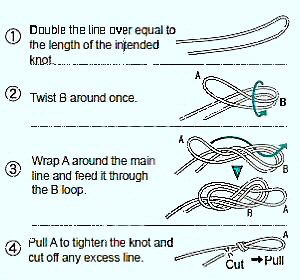
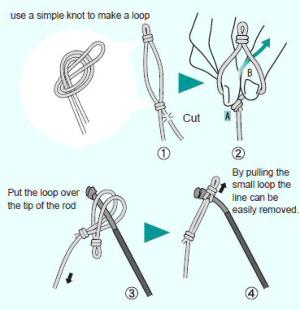
It can also be set up to attach the pole to the piece of elastic, placed inside the pole tip sections. The elastic is used to assist in fighting fish. Using elastic in the pole tip allows the fish to fight against something. It also helps to keep a tight line between the fish and pole tip. It can also protect the pole and float rig when the fish surges away. You can find more information in more details about elasticating fishing pole on How to elasticate a fishing pole page.
How to attach line with Haris using a swivel.


To prevent "Interwined" use smaller swivel. Tie guiding line with swivel by clind knot or uni knot. Then set haris. It is always better to use hook connected with haris first. You need to change the haris constantly to get a better result.
Back to top
How to attach float to the line
Rubber float stopper, "pipe stopper" is used to keep a float with a guiding line. Every rubber stopper has a certain size that fit with the line.
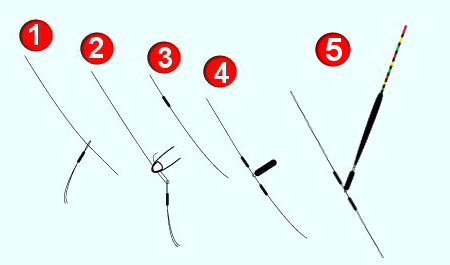
2. While holding the line with your finger, slide the rubber pipe up the line.
3. Slide the pipe up the line.
4. Attach the free moving float cap in between the two pipe stoppers. Make 2cm gap between the two stoppers.
5. Attach the float by sliding tightly the float stem to the free moving float cap. Slowly tighten.
How to adjust float, weights and line?
One of the most important and very first things to do is to work out the water depth and adjust your weights and line to get the float sitting right. The line should be adjusted according to the way the fish are feeding.
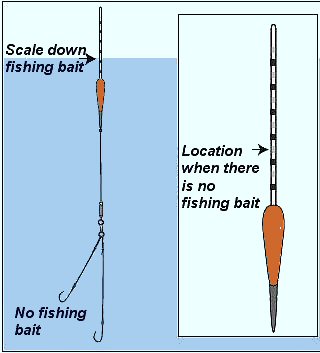
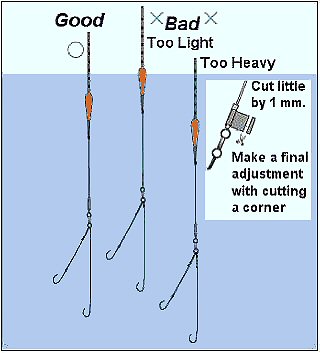

2. Add sufficient weight (depth measure) so that roughly the bottom area of the float's pole sinks below the water. Adjust the bait mark on the float, the point where the water comes up. When the bait mark shows up above the water means there is no more bait on the hook.
3. Attach some weight to the hook and cast into the water. The float should sinks below the water.
4. Removing some amount of the weight repeatedly cast the float into the water and slowly bringing the float higher until the float bristle just sticks out of the water.
5. Once the float is adjusted properly remove the weight (depth measure); it will leave your hook just sitting on the bottom.
Later while fishing if the bait isn't sitting properly on the bottom and you are only getting nibbles and not any good bites on the line it is good idea to adjust your rig by increasing the length of the line below the float by about 1 cm at a time. Keep doing it until your catch rate and strike rate are increased.
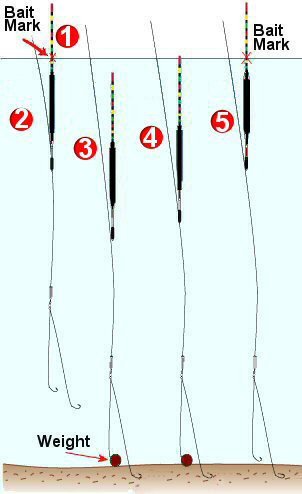
How to roll sinker around the line


1. Winding tissue paper or cotton thread around fixed part of the weight.
2. Crease with a scissor. The width of the crease is around 1.0mm - 1.5mm.
3. Put guiding fish line in the fold.
4. Fold it closely by your thumb to the roll up tightly and to make "Tune Circle". If you do not fold it closely enough it would be flat shape.
5. Roll it on a flat surface. If it looks "Flat", roll it on flat surface with pushing of hand hood. It helps to shape up.
How to attach swivel to the line and tie on the leader.
Double back and make 5-6 turns around the line.
Pass the end of the line through the first loop, above the eye, and then through the large loop. Draw the knot into shape.
Slide the coils down tight against the eye.
2. Cut extra line.
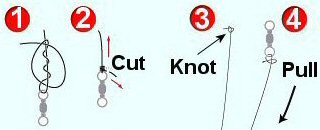
How to Cast Telescopic Carbon Pole Rod?
Telescopic flexible rods made of Graphite Carbon are extremely sensitive and must be handled with extra care. They could not be overloaded; casting should be done when sections are fully open but without using a force. No sideway pressure should be applied. You should also always keep the rod's power rating in mind and never use fishing line or bait that's too heavy, that can also lead to an unexpected breakage. They usually don't break while fighting the fish but they could break while casting if a wrong load is used or if too much pressure is applied to collapse the sections of the rods.
Casting of telescopic pole whip is very easy. There are 2 types of cast: under arm cast and overhead cast.
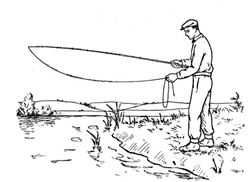
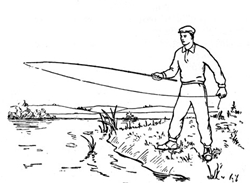
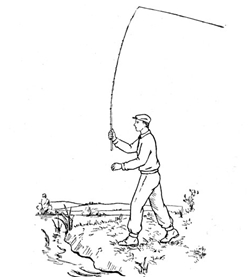
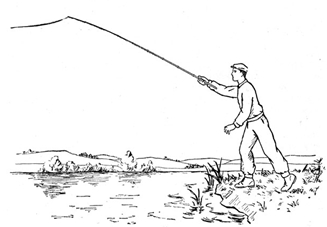
How to fish with a pole.
There are many varieties of poles available. They come in different lengths, strengths and designs. Poles provide a tremendously wide variety of fishing, using a fly, live bait or worm. They can be used to fish shallow or fast rivers, to small ponds or large lakes. The control that it gives you over your float tackle is superb. They can be used to 'bag-up' on small fish like
Roach, good fighters
Largemouth Bass and jumping
Trout or to tame the hard fighting
Carp. Poles allow you to fish with a great level of precision and sensitivity. It is a very popular technique with match fishermen, and when used in the hands of a professional, can result in a huge weight of fish. It really is something you have to see and try to believe.
There are a few different techniques that can be used to fish with a pole.
- Dabbling involves "dabbling baits" next to stumps, riverbanks, holes in moss beds and other tight spots. In these situations, a pole allows bait to be presented and retrieved over structure a rod and reel could not reach without fouling. This technique can be used with a variety of artificial lures and natural baits and with or without a bobber.
- Sling-shot In order to get a bait or lure under overhead structure like docks or limbs, hold hook by the bend, pull back to put tension on pole and release. The lure is "shot" ahead in whatever direction the pole is aimed. This technique is best performed with artificial lures.
- Strolling is basically manual trolling along a bank that is free from obstructions. To do so, simply walk along water's edge with pole extending at a right angle over the water. Be sure to extend the pole in or out to work around structure as you pass. This can be done with a variety of natural baits and artificial lures.
- After throwing the bait put the rod so that it will be comfortable quickly take it with your right hand. It is not recommend using more than two fishing poles at the same time. Excess fishing line can scare big fish, it can become entangled in fishing lines from other poles; a large number of floats are scattered your attention, and you may miss the most important bait.
- After setting the rods, you just need relax, sit and watch the floats. When you will see the movements of the float, which means that the fish touches the bait, put your hand on the rod, and closely follow the further movements of the float. Features baits, time of strikes and time of setting the hook when fishing with a float depend on many factors: kind of species, if the fish hungry, what kind of baits you are using, if tackle is noticeable or invisible - etc.
- When biting Perch and Ruffe float smoothly immersed in water. Preliminary moving swinging float rarely observed, mainly when the bait is large which makes it difficult to immediately take it whole in the mouth. When using a worm as a bait, then the first strike make the float to dive; when fishing on live bait you should not rush, better to wait a few seconds.
- Pike takes the bait just like Bass. Float usually without prior twitch rapidly disappears under the water, and continues to move parallel to the surface, but not in depth. After a few meters, sometimes up to 10, Pike stops and starts swallowing bait. If caught on live bait and medium-sized 2-3 hooks lure, set up the hook just a few seconds after immersion of the float; if caught on live bait and two large single hooks, better to wait a moment when the float after stopping starts moving again.
- Roach bite is very diverse. Large fish usually takes the bait confident and immediately drown the float. Smaller or satiated Roach - often shakes and swings float without dipping it, and only after long preliminary wiggles, a few jerks the float is sinking to the bottom or goes to the side. Especially incorrect bite is observed when using grain baits. You should make a sharp slicing down that could reliably detect a roach only when float is submerged or slowly moving aside. Even a small fish fiercely resisted, refusing to give up, so don't rush. Roach gets tired quickly, and then you can easily wind up in the landing net.
- Rudd and Ide, even large ones, take better than Roaches, the float after 2-3 swayings goes sideways or obliquely immersed in water. You should strike at the same time, like Roaches, when float is submerged or slowly moving aside.
- For Bream fishing is very typical when the float is switching from horizontal to vertical position. This is because Bream often takes the bait in the mouth in a vertical position from the bottom, and the float becomes horizontal when bream is moving up and raises sinker and a float. However this kind of bites is not always observed. Sometimes the float after several times shaking is sinking and slowly goes to the side. In this case you should strike when the float goes to the side or dived. When fishing with large bait you should strike as soon as the float will fall. If using Nightcrawlers and worms as a bait, better to wait until the float will go aside and starts immersed. Very carefully Bream takes peas and grains.
- Tench takes the bait sluggishly: float is rocking for a long time, sometimes it is strongly tilted, then slowly moved to the side. You should strike when float is moving aside.
- The bite of the Carp at first sometimes resembles bite of Tench, but after takes bait in the mouth, Carp confidently sink the float. You should strike when float submerged.
- When fishing on a float strikes are depend on the ratio of the length of the rod and the length of line. With a length of fishing line is just a little longer than the length of the rod; the strike is doing by short movement of the rod, working mostly with a brush and elbow. You should not do broad sweep of the rod in this case, as it gives less sharp, delayed slicing down, and when caught big fish can lead to breakage of line. If the line is long and float is released far, then slicing down should produce with a wider sweep of the rod with the shoulder in order to remove slack fishing line. In the correct slicing down the direction of the rod must be opposite to the movement of the float. In this case the applied force is transfered to the hook and the hook firmly hooked fish.
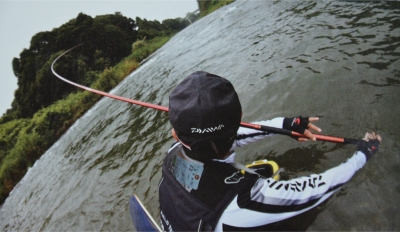
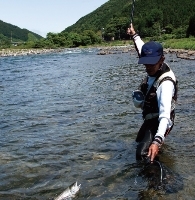
How to land a fish.
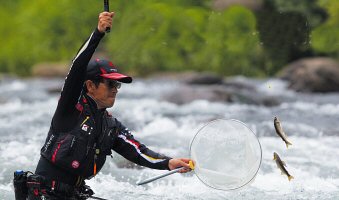
Catching fish using even strong fishing line, we should always strive to make line stretched as little as possible, because the hook often engages the tip of the fish lips or film in the mouth, and with a bigger effort it is often leads to breakage the line and loosing the fish.
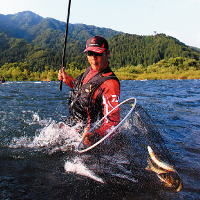
You must have a clear understanding of emerging forces when playing with the fish and when landing the fish. Fish in the water can develop a resistance force is 2-3 times greater than its own weight, the load on the gear changes proportional to the weight of fish and its velocity. At the highest power of resistance in the cast fish tired faster. This is why the main task of the angler - weary fish. When landing a fish overcomes the resistance of the water and the force with which an angler is trying to hold it, don't let her swim away. At low speeds, the energy required to overcome the resistance of the water is not so great, and the fish can swim for a long time without wearying. However, water resistance increases with the speed the fish is moving. At high speed fish spends a lot of energy, and she gets tired quickly. The force with which the angler is holding the fish also helps to loose energy, but when landing, to avoid breakage or fishing line or fish lips, angler should strive to reduce this force. This is where the well damping, extremely flexible and versatile Carbone rod comes to help angler.
You should never lift your catch, as the weight of the fish in the air is increasing dramatically and can be the reason of breakage or fishing line or fish lips and you loose the fish, or even worse, the tip could be damaged or broken and you loose your catch with the tip.
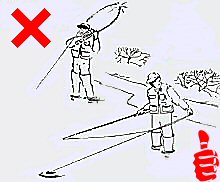
Should not let fish appear to the surface before it get tired, as it will beat and splatter, and can get off the hook. Do not pull the fish quickly if it appears to the surface. You should try to lower her down by tilting rod to water, but not forward, to the side, keeping the same angle between the fishing line and rod. If the fish jumped out of the water it is often recommended to lower the rod down and weaken the line, and when the fish fall into the water, raise the rod and pull the line back. However, when the fish jumps even 1 meter in height the line is not stretched enough to break her lip, and vice versa, when fish fall to the water, it does not appreciably weaken by flexible bending rod and stretching line.
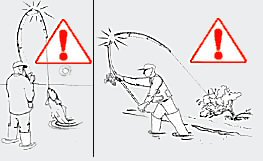
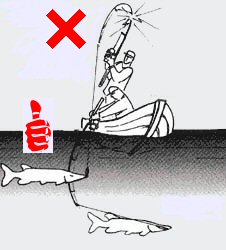
Another technique that works with longer Pole rods is to extend the rod all the way out past the fish so that the fish is between you and the tip of the rod. If you apply a little pressure on the line in the direction opposite to where you are, the fish will start struggling and moving towards you which is exactly what you want to happen. You might also keep the tip of the pole right above the fish to achieve the same result.
How to land the fish in the landing net.
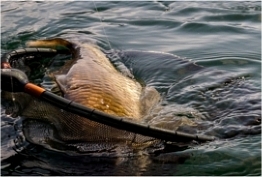
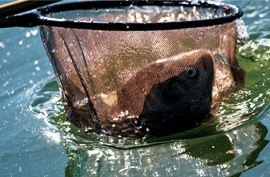
First, it is extremely important to know the basics of preparing fishing pole first before going into the details of artistic fishing. And the most important is that you start off with good equipment. And having a good equipment means having a good fishing pole.
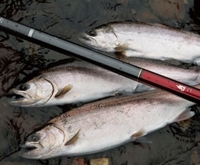
Several helpful Tips
Never lift your catch, always play with the fish and use landing net to land it. Always extend and insert telescopic sections very gently, try do not extend them too forcibly; try to keep it off the ground to avoid dirt getting into the joints. Wipe it clean with a cloth before taking it down so you don't jam dirt into the joint, rinse pole with freshwater after using it in saltwater as soon as you can. Always remember to take a good care of your poles and they will work for you for a very long time and will bring you large amount of catches and a huge amount of great emotions. More great emotions - longer and healthier is your life.
Back to topHow to Extend and Insert Telescopic Carbon Pole.
You should open and close the rod with a special care, always keep control of the rod sections. Pole rods can easily take even very heavy load, they are very strong and durable but they need to be handled with cared too. They usually don't break while fighting the fish but they could break while they are being closed without special care. Opening and closing these rods must be done very carefully and gently, no sideway pressure should be applied to the rod while closing it.
Opening Telescopic Carbon Pole.
Telescopic poles are very simple to open, but there are a couple of points to keep in mind to simplify the process and avoid damaging the rod.- Make sure to open the rod from the tip section to bottom one by one tightly and don't apply any sideway pressure, so the sections cannot move when twisted.
- Extend each section individually and make sure it's snug but not too tight before moving on to the next section. Do not apply too much pressure when pulling sections out as that could cause pieces to get stuck.
- Take off the plug at the end of the rod, pull out the tip with a lilian string by tilting the rod a little.
- Expose the section with the braided string first and attach the line to the tip.
- Pull out the rod section by section sliding each part between the fingers, and screw the joint of two sections till they are tightly fixed.
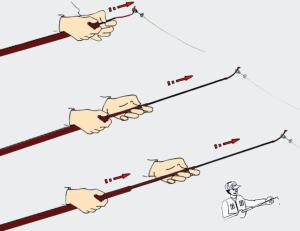
Once you're done shake the rod and see if you can hear any slight click signifying a "crack". If you do that means that one of the sections is not fully extended, identify it and extend it properly.
Back to topClosing Telescopic Carbon Pole.
- Loosen the joints by holding the two sides of joint and pull out while screwing, and draw in by turns section by section from end.
- Attention should be paid when drawing in to avoid pulling too forcibly, which may hurt your hand.
- Draw in the fishing rod from Butt section by turns. If in reverse, the end section may fall into other sections, and maybe cause damage to fishing rod.
- Bending the fishing rod too forcibly or using fishing line when it is in disorder may cause break of fishing rod.
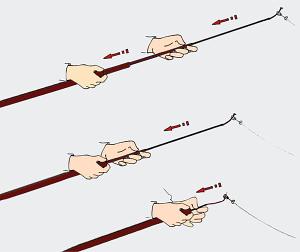
If rod sections get stuck at a joint:
The most frustrating things that can happen to a telescopic fishing rod (after braking) is to become jammed at a joint. Occasionally this can happen due to dirt/mud/sand in the joint but the main cause of the joints fixed too tightly is extending the rod too forcibly.
Prevention is better than cure: try not to extend the rod too forcibly; try to keep your rod off the ground at all times to avoid dirt getting into the joints. Wipe it clean with a cloth before taking it down so you don't jam dirt into the joint. If you've been using it in saltwater give it a quick rinse with freshwater as soon after use as you can. Its a good idea to put a protectant like WD-40, Tackle Guard or a silicon lube on the joints.
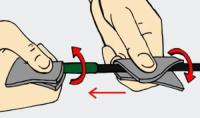

B. Pour hot water on large side of the joint as close to the joint as you can to rapidly expand it. Then after a few seconds try twisting or pushing the small side of the joint back down. It's best if you can do this under a tap where the water starts off cold then gets progressively warmer over a few seconds as this reduces the risk of stress cracks developing in the joint.
C. If the hot water technique fails try the next step up. Do the same as above but put ice on the small side of the joint to shrink it. This is easiest if you get some ice from your freezer place it on a cloth or towel and then wrap that around the rod and hold it while you heat the other side with hot water.
D. Try a penetrating lubricant like WD-40, CRC or Tackle Guard. Leave the joint to soak for an hour or two and then try gently to take the rod down.
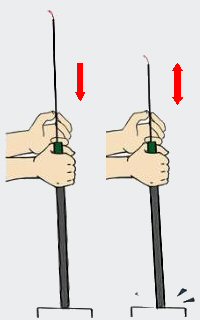
Z. If nothing helped buy another rod from our website and take more care of your fishing gear in the future!
Back to topTake a good care of your rod.
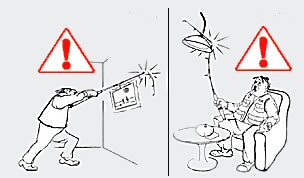

This is one of the most common causes of breakage and is 100% angler-caused
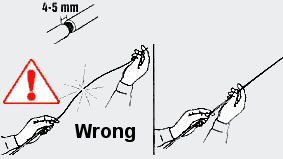

4. Be extra careful when getting your fishing rod out of the car, especially if it is a graphite rod. Too many people break their rod on the car door.
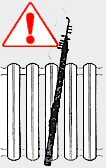
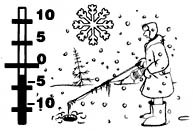
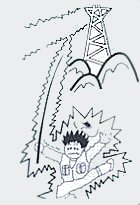
8. If you seal up the damp or sordid fishing rod, the moisture will possibly cause the bubbling or scaling off of lacquer. To prevent this, always rub off the moisture on fishing rod and keep it in a ventilated place. Never store a rod in its tube. Humidity can cause the moisture.
9. Always rub off the moisture, salt and dirt before storage.


Back to top


































